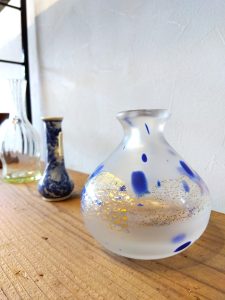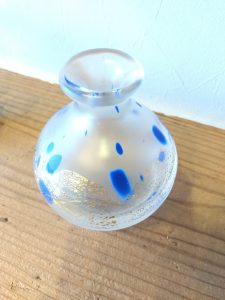思わず手に取りたくなる可愛さです(愛知県名古屋市千種区姫池通 骨董買取 古美術風光舎)
2024.03.22
みなさまこんにちは、スタッフTでございます。
寒さは感じるものの、いよいよ桜の開花も進みそうで楽しみです。

さて、風光舎に新しく仲間入りしたこちらは、藤田喬平の作品。鮮やかなブルーにころんとした丸い形は、思わず手に取りたくなる可愛らしさです。こちらは花瓶でしょうか。徳利として使うのもよいかもしれません。
日本を代表するガラス作家である藤田喬平は、色ガラスに金箔を混ぜた「飾筥(かざりばこ)」や「ベネチアン・グラスの」花瓶など、伝統的な技法を現代感覚でよみがえらせた作品で知られる作家です。世界的にも高く評価され、平成14年文化勲章も受章しました。
藤田喬平は1921年東京に生まれ、40年に東京美術学校(現東京藝術大学)工芸科に入り彫金を学びます。卒業後は岩田工芸硝子に入社しますが、間もなく独立し、ガラス作家としての道に進みます。64年には流動するガラスのオブジェ「虹彩」を発表し、注目を集めます。
金属を学んだ藤田喬平は、金箔や銀箔をガラスの中に溶かし込む技法を開発し、ガラス工芸の新しい分野を切り拓いていきます。国際的に第一線の作家として認められるきっかけとなったのは、日本の伝統的美意識をガラスという素材によって現代的に蘇らせた作品「飾筥(かざりばこ)」の発表です。
昭和48年に発表されると欧米で大きな反響を呼び「フジタのドリームボックス」の愛称で親しまれ、代名詞となりました。その後もガラス工芸の本場イタリアのベネチアン・グラスやスウェーデンのカット・グラスなどにも挑戦し、ガラス工芸の可能性を追求し続けました。
箱にも書かれております「手吹」とは、 溶けたガラス生地を竿に巻き取り、宙に向かってまわしながら吹き形を整える昔ながらの技法です。
吹きガラスのはじまりは諸説ありますが、紀元前1世紀頃にフェニキアのガラス職人が開発したという説が有名です。
型にガラスを流し込むのではなく、溶解炉などで高温融解したガラスを鉄パイプに巻き取り、口で空気を吹き込んで作るため「吹きガラス」という名前になりました。ガラスをまるで風船のようにふくらませて成型するこの技法は、現在もなお世界中で受け継がれているガラス製造技法の基本となっています。
ガラスの温度やその日の湿度などの環境、息の吹き込み方などの違いによって、一つとして同じ作品にならないのが手吹ガラスの一番の魅力とも言えます。
そもそも、ガラスはなぜ透明なのかというと、ガラス自体が光を吸収せず透過させるため。透過、つまり背景の色を透かすことができ、光に当たるとキラキラと反射させることが出来ます。この透過性が「美しい」という認識に繋がり、ガラスの器は宝物として扱われたり、装飾品の材料としても重宝されてきました。
「ガラス」と耳にしたとき、どんなイメージを思い浮かべますか?その魅力はなんといってもその見た目の良さでしょうか。光を通してきらきらと輝く様子は他にない魅力です。一方で、ぶつけたり落としてしまうと、即座に割れてしまうという繊細さも持ち合わせているのがガラスです。その繊細さが人を引き付ける要因かもしれませんね。
HPやSNS等でお知らせしておりますように古美術風光舎では、来月、4月5,6,7日、ここ覚王山の店舗におきまして『器と骨董展』を開催いたします。これまでブログ等でご紹介してきました器など、一度是非お手に取ってご覧いただけたらと思います。
6,7日は覚王山祭りも開催しておりますので、お祭りの寄り道にふらりとお立ち寄りくださいませ。
ではでは、また

Hello everyone, this is Staff T.
Although it feels cold, we are looking forward to the cherry blossoms finally coming into bloom.
Now, this is a new addition to Fukosha, a work by Kyohei Fujita. The vivid blue color and round shape are so cute that you can’t help but want to pick it up. Is this a vase? It may also be used as a sake cup.
Kyohei Fujita, one of Japan’s leading glass artists, is known for his works that revive traditional techniques with a modern sensibility, such as “Kazari-bako,” which is colored glass mixed with gold leaf, and “Venetian glass” vases. He was awarded the Order of Cultural Merit in 2002.
Kyohei Fujita was born in Tokyo in 1921, and entered the Crafts Department of Tokyo National University of Fine Arts and Music (now Tokyo University of the Arts) in 1940, where he studied metal carving. In 1964, he attracted attention with his “iris,” a flowing glass objet d’art.
After studying metals, Kyohei Fujita developed a technique for fusing gold and silver leaf into glass, opening up a new field of glass art. What led to his international recognition as a leading artist was the release of “Kazari-bako,” a work that revived the traditional Japanese sense of beauty in a modern way using glass as a material.
When it was unveiled in 1973, it made a huge impact in Europe and the United States, where it was nicknamed “Fujita’s Dream Box” and became synonymous with the brand. After that, Fujita continued to pursue the possibilities of glass craft by experimenting with Venetian glass from Italy, the home of glass craft, and cut glass from Sweden.
The “hand-blowing” described on the box is an old-fashioned technique of winding molten glass onto a rod and turning it in the air to form the shape of the blown glass.
There are various theories about the origin of hand-blown glass, but the most famous is that it was developed by Phoenician glassblowers in the 1st century BC.
The name “blown glass” comes from the fact that the glass is not poured into a mold, but is instead melted at high temperatures in a melting furnace, wound around an iron pipe, and blown into the air with a mouth. This technique of forming glass by blowing it up like a balloon is the basis of glassmaking techniques still used around the world today.
The most fascinating aspect of hand-blown glass is that no two pieces are alike, depending on the temperature of the glass, the humidity of the day, and the way the glass is blown.
The reason why glass is transparent is because glass itself does not absorb light but allows it to pass through. Transparency, in other words, allows the colors of the background to shine through, and when it is exposed to light, it can reflect it sparklingly. This transparency leads to the perception of “beauty,” and glass vessels have been treated as treasures and valued as materials for ornaments.
What image comes to mind when you hear the word “glass”? The most appealing thing about glass is its good looks. The way it glitters and shines through the light is uniquely attractive. On the other hand, glass is also delicate and can break instantly if it is bumped or dropped. This delicacy may be the reason why glass attracts people.
As we have announced on our website and SNS, we will be holding an exhibition of “Vessels and Antiques” at our store in Kakuozan on April 5, 6, and 7, 2012. We hope that you will take a look at the vessels that we have been introducing on our blog and other places.
The Kakuozan Festival will be held on the 6th and 7th, so please drop by on your way to the festival.
See you soon!
*******************
ご実家の整理やお片付けなどをされている方のご相談などが多くございます。
お片付けなどくれぐれもご無理のないようになさってくださいませ。
風光舎では古美術品や骨董品の他にも絵画や宝石、趣味のお品など様々なジャンルのものを買受しております。
お片付けをされていて、こういうものでもいいのかしらと迷われているものでも、どうぞお気軽にご相談下さいませ。
また風光舎は、出張買取も強化しております。ご近所はもちろん、愛知県内、岐阜県、三重県その他の県へも出張いたします。
まずは、お電話お待ちしております。
愛知県名古屋市千種区姫池通
骨董 買取【古美術 風光舎 名古屋店】
TEL052(734)8444
10:00-18:00 OPEN

